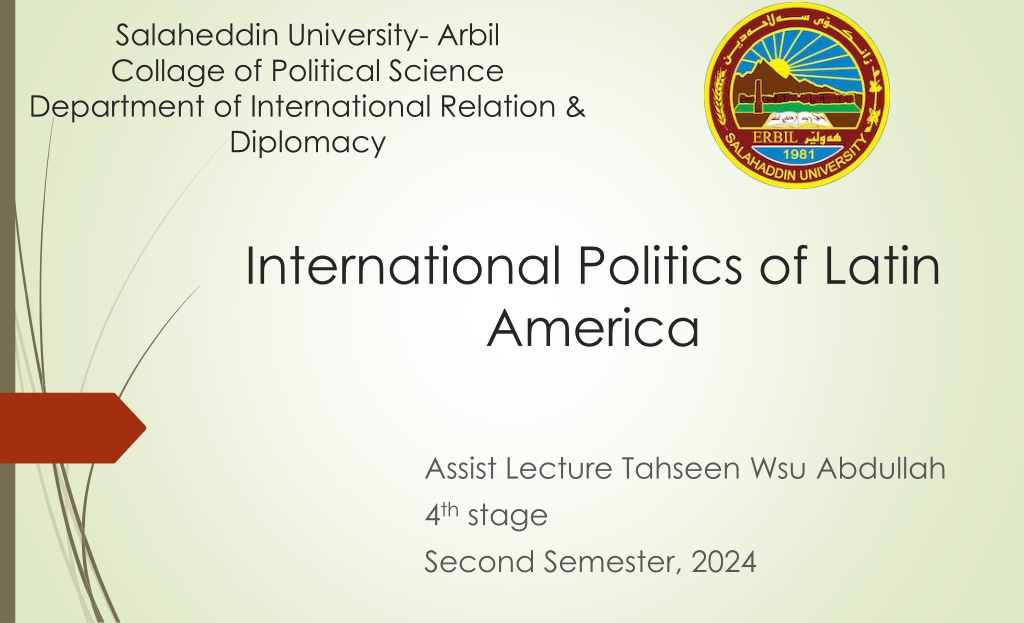
Latin America: Diversity, History, and Culture
Explore the diversity of Latin America, with its unique blend of Indigenous, European, African, and Asian populations. Learn about the rich history, languages, and social complexities that define this vibrant region. From colonial legacies to modern-day challenges, Latin America is a melting pot of cultures waiting to be discovered.
Download Presentation

Please find below an Image/Link to download the presentation.
The content on the website is provided AS IS for your information and personal use only. It may not be sold, licensed, or shared on other websites without obtaining consent from the author. Download presentation by click this link. If you encounter any issues during the download, it is possible that the publisher has removed the file from their server.
E N D
Presentation Transcript
Salaheddin University- Arbil Collage of Political Science Department of International Relation & Diplomacy International Politics of Latin America Assist Lecture Tahseen Wsu Abdullah 4thstage Second Semester, 2024
General Information about Latin America Latin America consists of 33 countries. Approximately 660 million people live in Latin America. Spanish and Portuguese are the predominant languages of Latin America, with Spanish being the official language of most countries on the Latin American mainland. Indigenous languages are widely spoken in countries like Peru, Guatemala, Bolivia, and Paraguay. Other European languages spoken in Latin America include English, German, Italian, Polish, Ukrainian, Russian, and Welsh. - Creole languages are spoken in several nations, especially in the Caribbean region, with Haitian Creole being the most widely spoken. French is spoken in Haiti, as well as in the French overseas departments of French Guiana, Guadeloupe, and Martinique in the Caribbean.
General Information about Latin America Latin American populations are diverse, with descendants of Indigenous peoples, Europeans, Africans, and Asians, as well as new immigrants, and social class was usually linked to a person's racial category. - In the colonial era, legal and social discrimination against non-white populations was established, and formal racial and legal distinctions disappeared in many places in Spanish America at independence in the early nineteenth century, although slavery was not uniformly abolished. - Significant black populations exist in Brazil and Spanish Caribbean islands, while the southern cone region is dominated by whites and mestizos, and Haiti and other areas in the French Caribbean are dominated mostly by blacks. - In the nineteenth century, several Latin American countries sought immigrants from Europe and Asia, and in twentieth-century Brazil, discrimination against darker citizens was observed, with whites remaining the elites in the country. - Indigenous groups have organized explicitly as Indigenous in many Latin American countries to claim human rights and influence political power, and with the passage of anti-colonial resolutions in the United Nations General Assembly, the Indigenous can act to guarantee their existence within nation-states with legal standing. -
Definition of Latin American Latin America is a region that is difficult to define. It is sometimes considered a geographic region that includes the entire Caribbean, i.e., all Western Hemisphere countries south of the United States, regardless of language spoken. It is defined by others as a region where a Romance language (Spanish, Portuguese, or French) predominates, or as a country with a history of Iberian (Spanish and Portuguese) colonialism. Latin America is defined as those nations where Spanish or Portuguese is currently the predominant language, according to the most restrictive definition the one used in this article. Therefore, the islands of Haiti and the French Caribbean, the Anglophone Caribbean (which includes Jamaica and Trinidad), the English-speaking countries of Belize and Guyana on the continent, and the Dutch-speaking countries of the hemisphere (Suriname, Aruba, and the Netherland Antilles) are not included.
Brief History Before the arrival of Christopher Columbus in 1492, Latin America had been settled for millennia by a wide range of indigenous groups, some of whom (Aztecs, Mayans, Incas) boasted advanced civilizations. The Spanish were the first Europeans to arrive in the Americas, followed soon after by the Portuguese, who colonized Brazil. Landing first in the Caribbean, the Spanish soon expanded their explorations and conquest to Central America, Mexico, and South America. The majority of Latin America gained independence from Spain between 1810 - 1825, with Brazil gaining independence from Portugal in 1825. Of Spain's two remaining colonies, Cuba gained its independence in 1898, at which time Spain ceded Puerto Rico to the U.S. in the Treaty of Paris that ended the Spanish American War.
Decades of independence Regions of Middle & South America Caribbean that were colonized by Europeans (Spanish, Portuguese & French). The map to the right shows the decades in which each country gained independence. and its






















